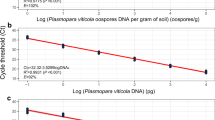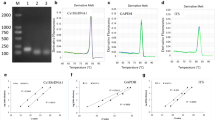Abstract
Potato early blight and brown spot are important fungal diseases responsible for premature defoliation and yield loss of potato. Pathogens considered to be involved in leaf necrosis are Alternaria solani and A. alternata, respectively. Both diseases are commonly characterized by the visualization of leaf lesions. Current detection and identification methods for Alternaria species rely primarily on cultural and morphological characteristics, the assessment of which is time-consuming and not always suitable. Sensitive, reliable methods for estimating infection severity are therefore desirable. In this study, an Alternaria-specific real-time PCR assay was developed using primers based on internal transcribed spacers (ITS) 1 and 2. The assays facilitated species detection and clearly discriminated between A. solani and A. alternata. The use of real-time PCR allowed quantitative estimation of fungal biomass in plant tissues. Detection sensitivities were in the range of >100 fg. Real-time PCR applications used to accurately assess the extent of colonization by Alternaria spp. during disease development are reported here for the first time. Additionally, Alternaria genomic DNA levels were verified not only in potato leaves showing different levels of disease progress, but also in symptomless leaves. This assay provides a useful tool to quantify pathogen levels during initial latent stages of infection and will thus help in the early detection and quantification of Alternaria spp..






Similar content being viewed by others
References
Bahnweg, G., Schulze, S., Möller, E. M., Rosenbrock, H., Langebartels, C., & Sandermann, H. (1998). DNA isolation from recalcitrant materials such as tree roots, bark, and forest soil for the detection of fungal pathogens by polymerase chain reaction. Analytical Biochemistry, 262, 79–82.
Bäßler, E., Asensio, N., Leiminger, J., Hausladen, H., Bahnweg, G., & Zinkernagel, V. (2004). Untersuchungen zum Auftreten und zur Bekämpfung von Alternaria solani und Alternaria alternata an Kartoffeln, Investigations on the appearance and control of Alternaria solani and Alternaria alternata on potato. Mitt. Biol. Bundesanst Land—Forstwirtschaft, 396, 100–101.
Boiteux, I. S., & Reifschneider, F. J. B. (1989). Potato early blight caused by Alternaria alternata in Brazil. Fitopatologia Brasileira, 14, 117.
Granovsky, A. A., & Peterson, A. G. (1954). Evaluation of potato injury caused by leafhoppers, flea beetles, and early blight. Journal of Economic Entomology, 47, 894–902.
Guillemette, T., Iacomi, B., & Simoneau, P. (2004). Conventional and real-time PCR based assay for detecting pathogenic Alternaria brassicae in cruciferous seed. Plant Disease, 88, 490–496.
Hausladen, H., & Leiminger J. (2007). Potato early blight in Germany (Alternaria solani – Alternaria alternata), PPO-Special report no. 12, Westerdijk, C.E., Schepers, H.T.A.M., (HRSG), Applied Plant Research BV, Wageningen.
Horsfield, A., Wicks, T., Davies, K., Wilson, D., & Paton, S. (2010). Effect of fungicide use strategies on the control of early blight (Alternaria solani) and potato yield. Australasian Plant Pathology, 39, 368–375.
Konstantinova, P., Bonants, P., van Gent-Pelzer, M., van der Zouwen, P., & van den Bulk, R. (2002). Development of specific primers for detection and identification of Alternaria spp. in carrot material by PCR and comparison with blotter and plating assays. Mycological Research, 106, 23–33.
Latorse, M. P., Schmitt, F., Peyrard, S., Veloso, S., & Beffa, R. (2010). Molecular analysis of Alternaria populations early blight causal agents in potato plants. In C. E. Westerdijk & H. T. A. M. Schepers (Eds.), PPO special report 14 (pp. 179–186). Wageningen: Applied Plant Research BV.
Leiminger, J. H., & Hausladen, H. (2012). Early blight control in potato using disease-orientated threshold values. Plant Disease, 96, 124–130.
Pasche, J. S., Wharam, C. M., & Gudmestad, N. C. (2004). Shift in sensitivity of Alternaria solani in responses to QoI fungicides. Plant Disease, 88, 181–187.
Pasche, J. S., Piche, L. M., & Gudmestad, N. C. (2005). Effect of the F129L mutation in Alternaria solani on fungicides affecting mitochondrial respiration. Plant Disease, 89, 269–278.
Pavón, M. Á., González, I., Pegels, N., Martín, R., & García, T. (2010). PCR detection and identification of Alternaria species-groups in processed foods based on the genetic marker Alt a 1. Food Control, 21, 1745–1756.
Pavón, M. Á., González, I., Martín, R., & García, T. (2012). A real-time reverse-transcriptase PCR technique for detection and quantification of viable Alternaria spp. in foodstuffs. Food Control, 28, 286–294.
Pyror, B. M., & Michailides, T. J. (2002). Morphological, pathogenic, and molecular characterization of Alternaria isolates associated with Alternaria late blight of pistachio. Phytopathology, 92, 406–416.
Rosenzweig, N., Atallah, Z. K., & Stevenson, W. R. (2008). Evaluation of QoI fungicide application strategies for managing fungicide resistance and potato early blight epidemics in Wisconsin. Plant Disease, 92, 561–568.
Rotem, J. (1994). The genus Alternaria, biology and pathogenicity. Minnesota: APS Press.
Schena, L., Nigro, F., Ippolito, A., & Gallitelli, D. (2004). Real-time quantitative PCR: a new technology to detect and study phytopathogenic and antagonistic fungi. European Journal of Plant Pathology, 110, 893–908.
Schuhegger, R., Ihring, A., Gantner, S., Bahnweg, G., Knappe, C., Vogg, G., Hutzler, P., Schmid, M., van Breusegem, F., Eberl, L., Hartmann, A., & Langebartels, C. (2006). Induction of systemic resistance in tomato by N-acyl-L-homoserine lactone-producing rhizosphere bacteria. Plant, Cell and Environment, 29, 909–918.
Selim, S., Roisin-Fichter, C., Andry, J. B., Bogdanow, B., & Sambou, R. (2013). Real-time PCR to study the effect of timing and persistence of fungicide application and wheat varietal resistance on Mycosphaerella graminicola and its sterol 14α-demethylation-inhibitor-resistant genotypes. Pest Management Science. doi:10.1002/ps.3525.
Singh, R. P., Singh, M., & King, R. R. (1998). Use of citric acid for neutralizing polymerase chain reaction inhibition by chlorogenic acid in potato extracts. Journal of Virological Methods, 74, 231–235.
Stammler, G., Böhme, F., Philippi, J., Miessner, S., & Tegge, V. (2014). Pathogenicity of Alternaria-species on potatoes and tomatoes. In C. E. Westerdijk & H. T. A. M. Schepers (Eds.), PPO special report 16 (pp. 85–96). Wageningen: Applied Plant Research BV.
Stevenson, W. R., & James, R. V. (2007). Evaluation of fungicides to control early blight of potato – Hancock. Plant Disease Management Reports, 2, V050.
Tylor, E., Bates, J., Kenyon, D., Maccaferri, M., & Thomas, J. (2001). Modern molecular methods for characterization and diagnosis of seed-borne fungal pathogens. Journal of Phytopathology, 83, 75–81.
Udayashankar, A. C., Chandra Nayaka, S., Archana, B., Anjana, G., Niranjana, S. R., Mortensen, C. N., Lund, O. S., & Prakash, H. S. (2012). Specific PCR-based detection of Alternaria helianthi: the cause of blight and leaf spot in sunflower. Archives of Microbiology, 194, 923–932.
van der Waals, J., Korsten, L., & Denner, F. D. N. (2003). Early blight in South Africa: knowledge, attitudes and control practices of potato growers. Potato Research, 46, 27–37.
Viskonti, A., & Chelkowski, J. (1992). Alternaria Biology, plant diseases and metabolites, eds. Amsterdam: Elsevier Verlag.
Wharton, P. S., & Kirk, W. W. (2007). Early blight michigan potato diseases series. MSU Extension bulletin, E-2991.
Zur, G., Shimoni, E. M., Hallerman, E., & Kashi, Y. (2002). Detection of Alternaria fungal contamination in cereal grains by a polymerase chain reaction-based assay. Journal of Food Protection, 65, 1433–1440.
Acknowledgements
We thank Ralph Hückelhoven for critical reading of the manuscript.
Author information
Authors and Affiliations
Corresponding author
Rights and permissions
About this article
Cite this article
Leiminger, J., Bäßler, E., Knappe, C. et al. Quantification of disease progression of Alternaria spp. on potato using real-time PCR. Eur J Plant Pathol 141, 295–309 (2015). https://doi.org/10.1007/s10658-014-0542-2
Accepted:
Published:
Issue Date:
DOI: https://doi.org/10.1007/s10658-014-0542-2




